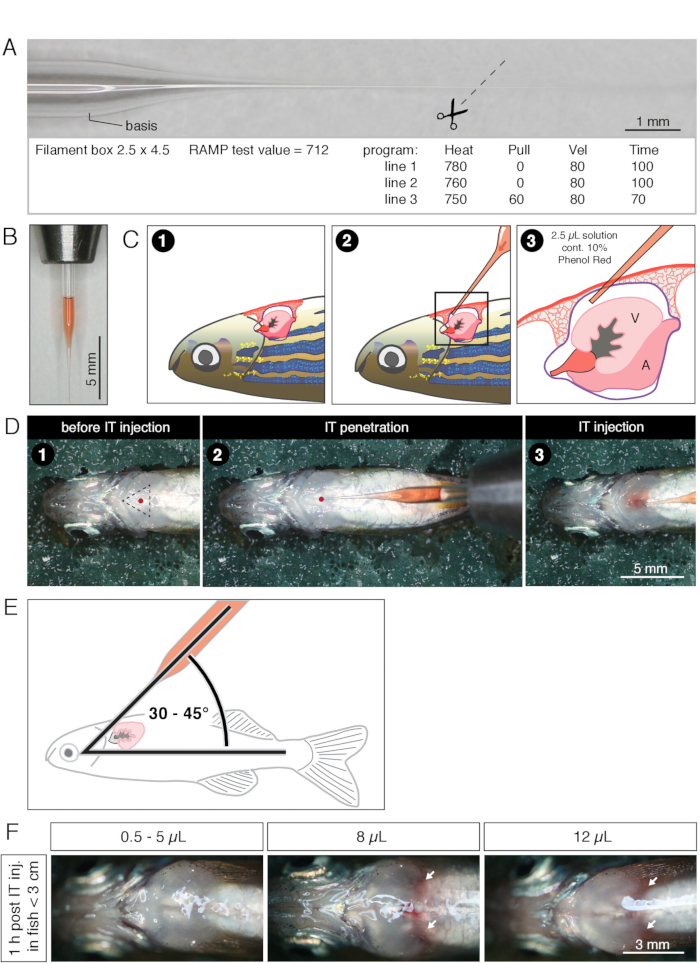このコンテンツを視聴するには、JoVE 購読が必要です。 サインイン又は無料トライアルを申し込む。
Intrathoracic Injection: Compound Delivery to the Adult Zebrafish Heart
Overview
This video describes the technique of delivering compounds into the heart of adult zebrafish by using intrathoracic injection.
プロトコル
1. Preparation of the Fish for Intrathoracic Injection
- Catch an adult zebrafish (Danio rerio) with a net and transfer it into the anesthetic solution.
- After 1−2 min, when fish stops swimming and the movement of operculum is reduced, touch the fish with a plastic spoon to make sure it does not react to any contact.
- Quickly and carefully transfer the fish with the spoon into the groove of the wet sponge, with ventral side up. The head of the fish should point away from the operator’s dominant-hand.
2. Microinjection into the Pericardium
- Under the stereomicroscope, carefully observe the movement of the beating heart under the skin of the fish. Visually determine the injection point above the beating heart and in the middle of the triangle defined by the ventral cartilaginous plates (Figure 1D). Insert the tip of the capillary at 30−45° degree angle relative to the body axis (Figure 1E). Gently penetrate the skin with the tip of the microcapillary into the pericardium (Figure 1C). An optimal entry point is closer to the abdomen than to the head.
NOTE: Do not insert the capillary too deeply into the body and the heart, as this will cause injury to the organ. In case of heart puncture, the needle generally fills with blood. If this happens, remove the capillary and exclude the fish from the experiment. - Once the needle is inside the pericardium, complete injection by pressing the pedal of the microinjector device.
NOTE: Be careful not to inject air into the thoracic cavity. - After injection, gently withdraw the capillary from the thorax and immediately transfer the fish into a tank with system water for recovery.
- Monitor the fish until total recovery from anesthesia.
- Collect heart at the desired time point and prepare it for further analysis.
NOTE: In case the fish does not resume movement of the operculum within 30 s, reanimate the fish by squeezing water into the gills with a plastic pipette.
結果

Figure 1: Intrathoracic (IT) injection in adult zebrafish. (A) Photograph of a pulled microinjection capillary with filament (6”, 1.0 mm in diameter) and values of the needle puller program used. (B) Photograph of a pulled microinjection capillary with filament (6”, 1.0 mm in diameter) filled up with 2.5 µL of solution containing 10% phenol red. The pulled tip of the needle is maximally 7 mm long. (C...
資料
| Name | Company | Catalog Number | Comments |
| Macroscope (binocular) | M400 | with Apozoom | |
| Micro-injector femtojet | Eppendorf | 5247 0034 77 | |
| Microloaders femtotips | Eppendorf | 5242 956.003 | |
| Micropipette glass needles type C | WPI | TW100F-6 | thin-wall capillary |
| Micropipette puller model P-87 | Flaming/Brown | 20081016 | filament box 2.5 mm x 4.5 mm |
| Sponge | any | any | dim. carved sponge 7cm x 3 cm x 1 cm |
| Tricaine (Anestethic) | Sigma | E10521 |
参考文献
This article has been published
Video Coming Soon
Source: Bise, T., et al. Intrathoracic Injection for the Study of Adult Zebrafish Heart. J. Vis. Exp. (2019).
Copyright © 2023 MyJoVE Corporation. All rights reserved